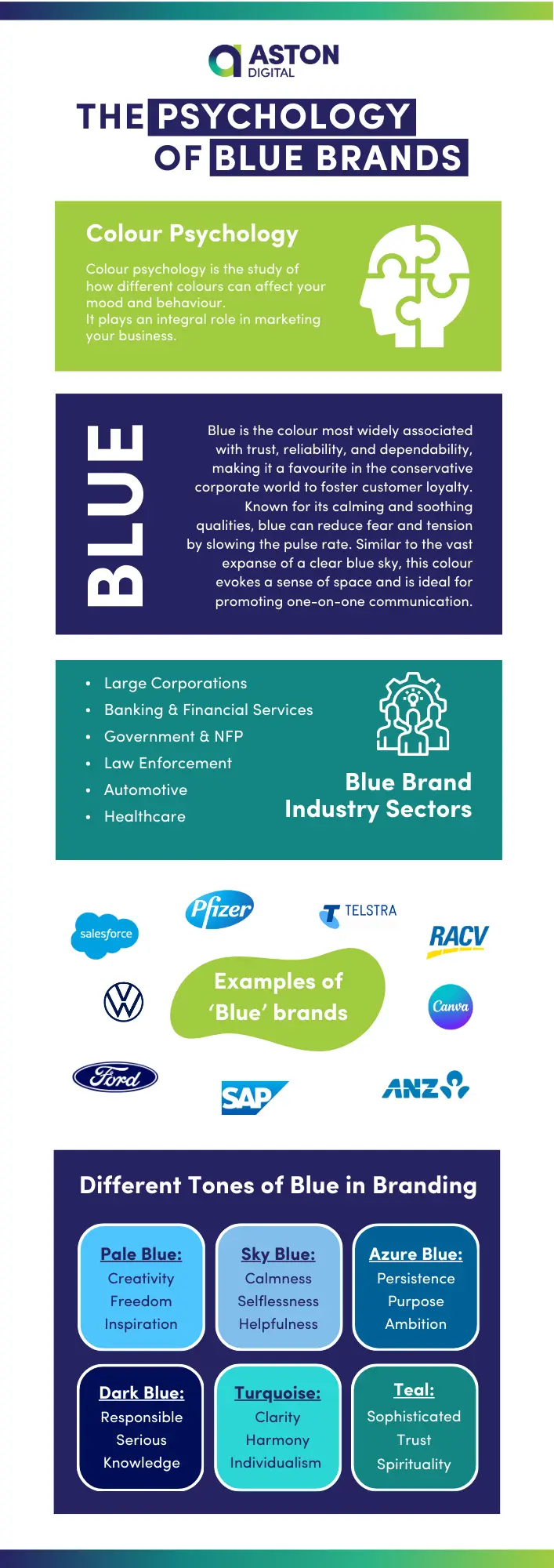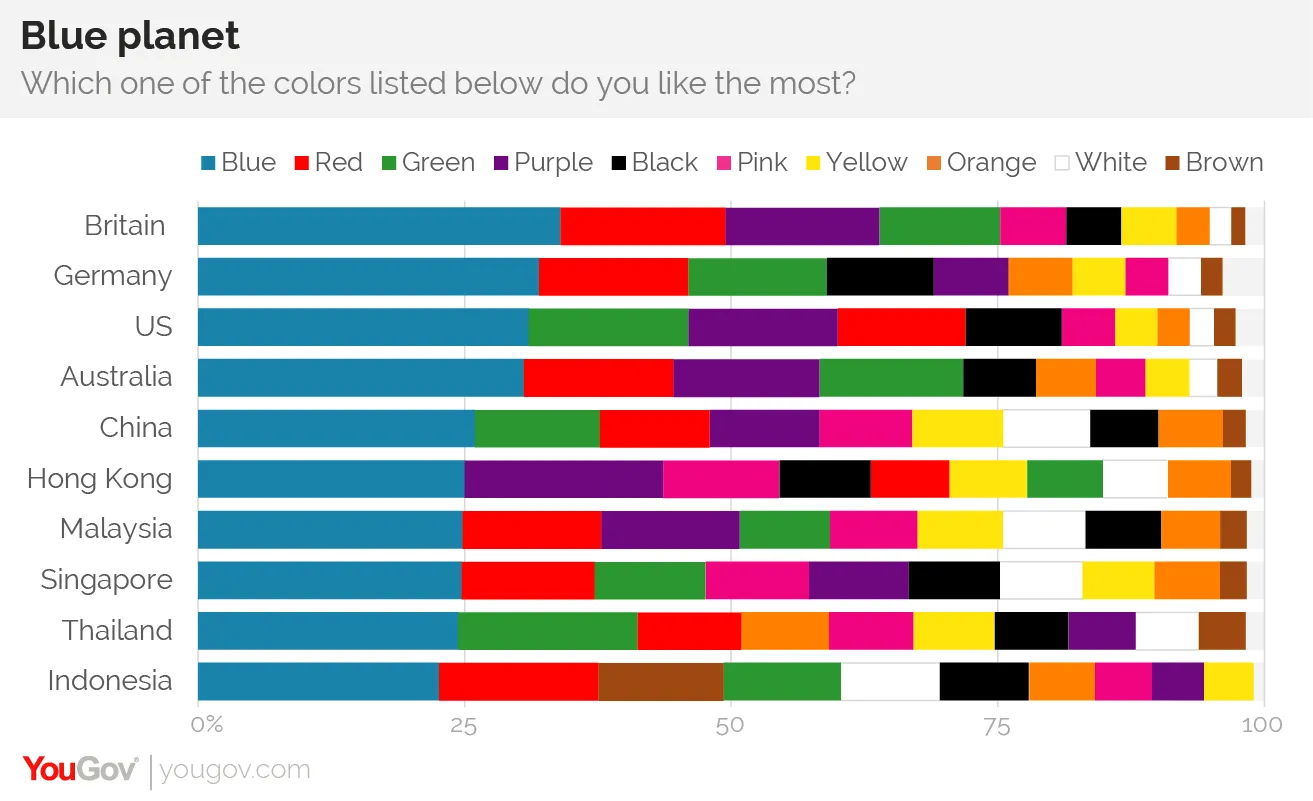What is a Blue Brand?
Understanding Blue Brands
Explore the psychological and cultural significance of the colour blue in branding. Blue brands are typically associated with trust, professionalism and calmness, making the colour a popular choice for industries like finance, healthcare and technology. Research highlights that blue conveys reliability and competence, and its universal appeal transcends age and gender. Blue’s versatility allows it to maintain its positive attributes across various shades, making it a strong choice for global and corporate branding efforts.
Reading Time: 12 minutes
Table of Contents
Colours and Branding

Modern psychology has provided insights into many previously unexplored areas, including the study of colour.
Color psychology is a branch of colour theory that examines our emotional and psychological reactions to various shades.
Red, for instance, is a powerful colour that evokes energy, both positive and negative. It can bring about excitement and celebration, or conflict and tension. Red has been scientifically shown to elevate blood pressure. This psychological impact enhances the significance of the colour, making its effect on branding a very important consideration.
Red raises blood pressure!
Think of our example of red. Because of its connection to higher blood pressure and faster metabolism, fast food companies often advertise red.
Taking red as our example, given its ability to have a real meta-physical impact on the viewer (raising blood pressure, increasing metabolism), principally sales-focused organisations will often use it. You will often see fast food outlets branded red, just as you will Real Estate agents (however Real Estate agents often use a combination of Blue & Red in an attempt to cover both bases).
You’ll find that yellow and orange also show up in the fast food industry and real estate sector, due to the bright and warm nature of the colours.
Calm, trustworthy and caring.
By contrast, blues and greens tend to show up in other industries. Industries that are either more corporate or more ‘caring’. You’ll find blues often in large corporations and greens in healthcare organisations.
There is nothing mandatory about the use of one colour over another. Just because you’re in a given industry doesn’t mean that you must use any given colour. More often than not the colour chosen is a reflection of the company culture and values – as applies to their given industry. There is no blanket solution.
The colour that you choose for your brand is entirely up to you, but you should choose your colour carefully, not all branding colours are created equal.
Foundations of Blue as a brand colour
If you start to think about objects that are coloured blue, you might rapidly come up with things like the sky, the ocean, blueberries, butterflies or even cheese!
However, one of its most interesting characteristics is the fact that, in traditional colour theory, it’s a primary colour. Along with Red and Yellow, Blue makes up one of the primary colours from which all other colours are made up of.
Being a primary colour has resulted in blue being commonly used in children’s toys. This often sparks sub-conscious nostalgia in people’s minds.
Childhood memories.
Blue can signify professionalism, creativity, peace and reliability. It often appears tranquil and calm but can also convey iciness or coldness in different contexts.
Although this range of meanings might seem too broad to be meaningful, it’s not. This becomes clear when considering what blue does not represent.
Blue is not usually associated with warmth, energy, anger or aggression. Instead, it leans towards stability and confidence.
Popular the world over
Surveys indicate that blue is the most popular colour in numerous countries, even in those where other colours are traditionally associated with luck.

Blue still attracts the preference of women worldwide, even though it is not typically seen as “girly,” a common and unfortunate criticism of pink, making it a colour without imaginary gender boundaries.
Furthermore, even those who favour other colors do not perceive blue as threatening or confrontational, and it lacks the “ugly” connotation often associated with colors like brown.
Blue for big and small alike
For companies aiming for global success, the worldwide popularity of blue is clearly advantageous. However, even local businesses should consider the power of blue in their branding efforts, as salespeople often struggle to avoid appearing pushy.
Due to its positive psychological associations and subdued nature, blue is less likely to come across as obnoxious compared to shades like yellow or red. Even at its brightest, blue can convey energy without seeming too in-your-face.

The majority of people favor the colour blue, but that’s not all. It is particularly preferred by men, yet it is not restricted to them alone and is versatile enough to attract the preference of all ages.
In short, blue is a universally liked colour that transcends age, gender and nationality, making it an excellent choice for a wide range of applications.
Finally, blue can be used in various shades without losing its quality. Unlike yellow, which can look like a murky grey-brown when mixed with black, blue maintains its appeal across a spectrum from dark to light. This versatility is essential for the diverse demands of modern branding, such as ensuring text readability and creating eye-catching displays.
Meanings of Blue as a Brand colour
Positive Implications of Blue Branding in Business
- Honest and Trustworthy
- Loyal, Dependable and Responsible
- Conservative and Persistent
- Idealistic and Organised, Authoritative
- Devoted and Thoughtful
- Tactful, Compassionate and Caring
- Peaceful and Calm
Negative Implications of Blue Branding in Business
- Inflexible
- Deceptive and Vindictive
- Self-Righteous, Superstitious and Emotionally Unstable
- Overly Conservative, Predictable and Weak
- Unforgiving and Cold
- Manipulative, Unfaithful and Distrusting
Different Tones of Blue in Branding
Pale Blue: Inspires creativity, freedom and inspiration
Sky Blue: Promotes calmness, selflessness and helpfulness
Azure Blue: Reflects determination, purpose, and ambition
Dark Blue: Conveys responsibility, seriousness and knowledge
Turquoise: Symbolises clarity, harmony and self-expression
Teal: Represents sophistication, trust and spirituality
What it means to be a Blue Brand
When we refer to a “blue brand,” we’re diving into the deeper connotations of what the colour blue signifies in the branding world. This concept goes beyond the mere choice of blue for logos or marketing materials; it encompasses the culture, feel, vibe and intrinsic values that the colour blue brings to a brand’s identity. Based on these characteristics it’s also common-place that blue brands operate in specific industry sectors.
1. Trust and Reliability
Blue is universally associated with trust and dependability. Brands that adopt blue aim to convey a message of stability and reliability. Companies like IBM and American Express use blue to assure their customers of their trustworthiness and consistent performance.
2. Professionalism and Competence
Blue exudes a sense of professionalism and competence. It’s a popular choice among financial institutions, tech companies and corporations that want to project an image of expertise and authority. Blue signifies that the brand is knowledgeable and capable in its field. For instance, JP Morgan and Intel use blue to highlight their industry leadership.
3. Calmness and Serenity
The calming effect of blue is well-documented. Brands in the healthcare, wellness and lifestyle sectors often use blue to evoke feelings of peace, relaxation and tranquility. It’s a colour that reassures and comforts, making it ideal for industries focused on wellbeing. Look at Pfizer and Oral-B as examples.
4. Innovation and Technology
In the tech world, blue is synonymous with innovation and forward-thinking. Brands like Dell and Samsung utilize blue to highlight their cutting-edge technology and commitment to innovation. It’s a colour that denotes progress and the future.
5. Global and Corporate Strength
Blue has a global appeal and is seen as a strong corporate colour. It transcends cultural boundaries, making it a preferred choice for multinational companies. The colour blue communicates strength, reliability and corporate stability, which is why it’s favoured by global brands like Ford and Unilever.
6. Coolness and Calm Control
The cool tone of blue suggests a sense of calm control. It’s not overly emotional or aggressive, but rather steady and controlled. This makes blue a perfect choice for brands that want to convey a calm, controlled and confident demeanor. For example, LinkedIn and Visa use blue to reflect their calm and collected corporate image.
By embodying these qualities, a blue brand establishes a strong, reliable and professional identity that resonates with a broad audience. Whether in the tech industry, financial sector, healthcare or global market, blue brands leverage the inherent qualities of the color to build trust, convey competence and evoke a sense of calm assurance.
Blue Brand Industry Sectors
Whilst not something mandatory or any sort of rule, it is common that Blue Brands tend to exist more in some industry sectors than others. Companies within these sectors tend to exhibit similar value sets and usually align on some or all of the value/characteristics outlined above. Some of the more common industry sectors are outlined below.
1. Large Corporations
Also known as ‘corporates’, companies that exist in this sector are often multi-national with client bases worldwide offering a diverse range of products and services. They are also often publicly traded companies meaning it’s important to them to demonstrate confidence and reliability to their shareholders as well as their customers.
2. Banking & Financial Services
When you’re dealing with people’s money it’s pretty important to appear as trustworthy as you can! Banks and other financial service providers such as lenders or insurers utilise blue heavily to build trust in their brand. As always, this isn’t strictly a rule, we can think of banks that don’t use blue at all (example NAB or Commonwealth Bank) but it is fairly common-place.
3. Government & Not-For-Profit
Governments and government organisations the world over employ blue to build trust in their brands. This also extends to Not-For-Profit organisations who will frequently use blue to illustrate their credibility. Even political parties will selectively use blue to align (or not) with their voter base. As an interesting note, many brands in this sector many not actually use blue in their branding but they will demonstrate the values outlined above in their company culture.
4. Law Enforcement
‘The boys in blue’ is a phrase for a reason! Police forces the world over use blue in their branding as a symbol of Trust and Authority, using blue to help convey a sense of professionalism and dependability. Interestingly law enforcement agencies use blue because of its calming effect. In high-stress situations, the presence of blue can help diffuse tension and promote a sense of order and calmness.
5. Automotive
The big blue oval (Ford) is one of the oldest known automotive brands and unsurprisingly happens to be blue! Automotive companies use blue to illustrate trust and reliability whilst also using blue to show their strength in innovation and technology. Blue is often linked with innovation, technology and forward-thinking. For automotive brands, this association aligns well with the industry’s emphasis on cutting-edge technology and continuous improvement.
6. Healthcare
Look at the logo of many hospitals and you’ll see blue if not as the main colour but certainly as a feature. Healthcare organisations use blue to show a raft of different characteristics like cleanliness and hygiene, professionalism and competence, not to mention healing and wellness. This may seem obvious, but you don’t frequently see a healthcare brand using a red or orange logo!
Is my brand a Blue Brand?
Having understood what a Blue Brand is, the next question you might have is;
Do I count as a Blue Brand?
The simple answer to this question is, ‘Is your logo blue?’ That’s generally the starting point. Of course it’s not that simple though. The bigger answer is, at it’s core, does your brand represent the values outlined above? Is your brand operating in one or more of the industries outlined above? Is your brand not considered conventionally ‘exciting’ but is still a very important and necessary part of society?


Our experience with Blue Brands
Our experience with Blue Brands includes everything from social media strategy, website development, social media management, social media advertising, and search engine optimisation. We’ve worked with organisations all across Blue Brand industries, including:
- Victoria Police
- Uniting Vic/Tas
- Nepean Blue Mountains PHN (Wentworth Healthcare)
- Australian Defense Force
- Victorian Government
- Dial Before You Dig (now known as Before You Dig)
- Metcash
- Phebra Pharmaceuticals
Why work with us?
Social Media Strategy has been a core service of ours since 2012. Fun fact: We used to be known as Aston Social!
We’ll help you reach your targets
KPIs are the focal point of our digital marketing strategies. We’re always striving to meet the expectations of your department.
We live for detail
Our reporting system offers valuable insights into how your campaigns are performing, the audiences who are engaging with them and competitor analysis.
No one understands the “blue brands” like we do
We are well aligned with professional and corporate businesses in industries including government, not-for-profit, law enforcement, healthcare, automotive, civil construction, adventure and lifestyle.

Looking for a complete Digital Marketing Plan? Discover our Digital Brand Story Framework!
Everything you do online is driven by your brand; what your brand stands for, what you do, what your proposition is, why people should listen, etc.
Understanding your brand is vital. That’s why we first start by defining your brand in terms of a Hollywood movie script. The Brand Story outlines who your customer is, what they want, why they want it and how you’re going to help them get it.
If you’re wanting to start your digital marketing strategy from scratch, or review your existing strategy, our Digital Brand Story framework might be for you!



